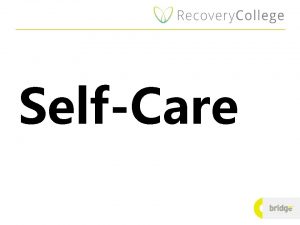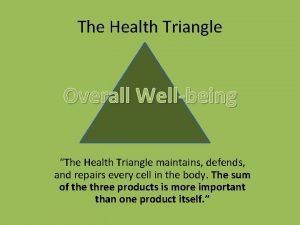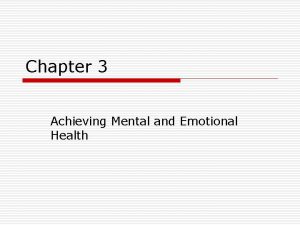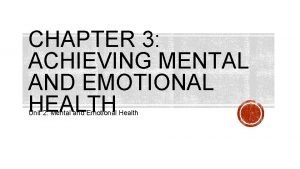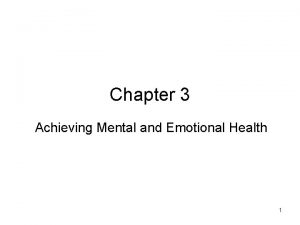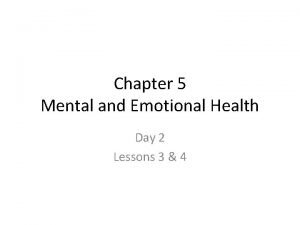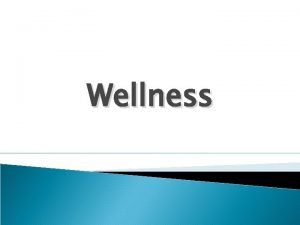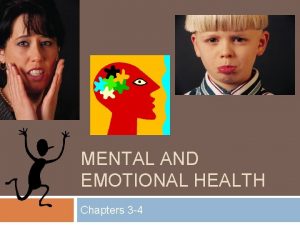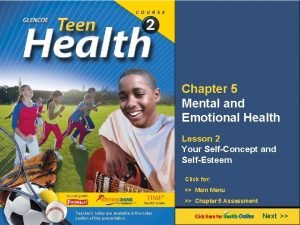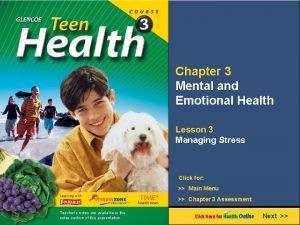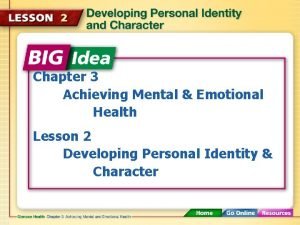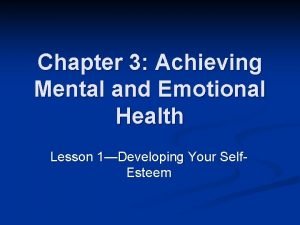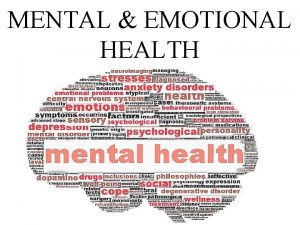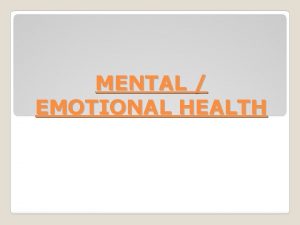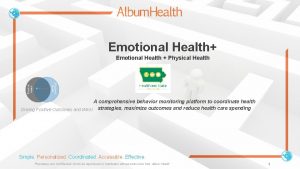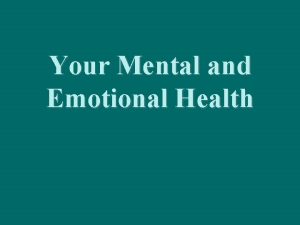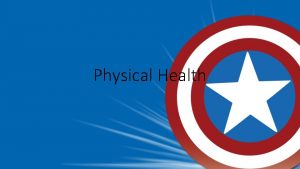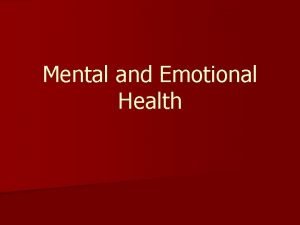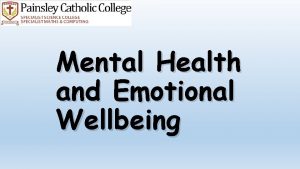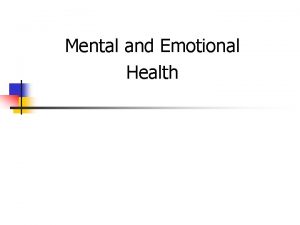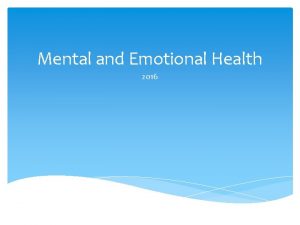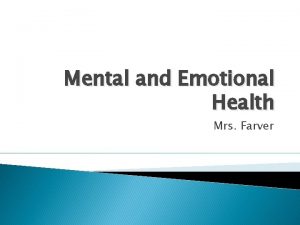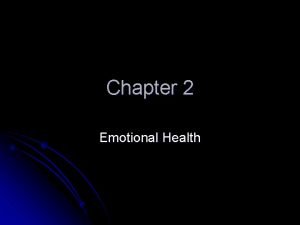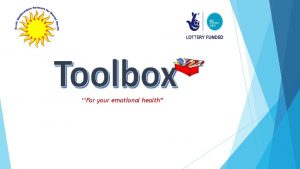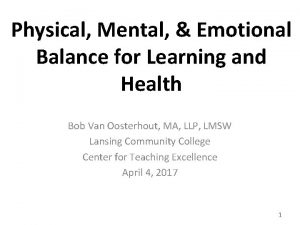Mental Emotional Physical Health What is mental health




















- Slides: 20

Mental, Emotional, Physical Health

What is mental health? ● Mental health includes our emotional, psychological, and social well-being. ● It affects how we think, feel, and act. ● It also helps determine how we handle stress, relate to others, and make choices. ● Mental health is important at every stage of life, from childhood and adolescence through adulthood.

Impact of mental health problems ● It is a normal part of development for teens to experience a wide range of emotions. ● It is typical, for instance, for teens to feel anxious about school or friendships, or to experience a period of depression following the death of a close friend or family member. ● Mental health disorders, however, are characterized by persistent symptoms that affect how a young person feels, thinks, and acts. ● Mental health disorders also can interfere with regular activities and daily functioning, such as relationships, schoolwork, sleeping, and eating.

Negative mental health Positive mental health ● ● ● ● Eating or sleeping too much or too little Pulling away from people and usual activities Having low or no energy Feeling numb or like nothing matters Having unexplained aches and pains Feeling helpless or hopeless Smoking, drinking, or using drugs more than usual Feeling unusually confused, forgetful, on edge, angry, upset, worried, or scared Yelling or fighting with family and friends Experiencing severe mood swings that cause problems in relationships Having persistent thoughts and memories you can't get out of your head Hearing voices or believing things that are not true Thinking of harming yourself or others Inability to perform daily tasks ● ● ● ● Realize their full potential Cope with the stresses of life Work productively Make meaningful contributions to their communities Learn easier Feel like you have a purpose in life Responding to stressful situations appropriately High energy Feeling calm, relaxed, controlled emotionally Able to help others who might be on the other side of this chart Keeping a Positive Mental Attitude (P. M. A. ) Better performance in enjoyable activities like sports and arts. Higher self-esteem Smiling or laughing more often

How do I maintain positive mental health? ● ● ● ● Getting professional help if you need it Positive Mental Attitude Staying positive Getting physically active Helping others Getting enough sleep Developing coping skills Smiling

Physical Activity

Let’s talk! ● Physical Activity Any kind of movement that uses up energy ● Exercise A specifically planned and organized session of physical activity that you do to improve or maintain your physical fitness ● Physical Fitness The ability to handle the physical demands of everyday life without becoming overly tired

Benefits of Physical Activity ● Mental/Emotional ○ Feel more alert and energetic ○ Reduce stress ○ Learning new things ○ Get a sense of accomplishment ○ Lessen mental fatigue ○ Build a positive self-image ○ Increase self-confidence and selfesteem

Benefits of Physical Activity ● Physical Benefits ○ ○ ○ ○ ○ Strengthen heart and lungs Strengthen bones Manage weight Control blood pressure Increase strength and stamina Improve flexibility and muscle tone Improve balance and coordination Improve reaction time Improve immune system Improve sleep

Benefits of Physical Activity ● Social Benefits ○ ○ ○ Engage in enjoyable activities Meet and interact with new people Work with others as a team Get support from friends Share goals and achievements with others

MVPA ● MVPA means “moderate to vigorous physical activity” ● Moderate physical activity○ Sustained, repetitive, large muscle movements (e. g. , walking, jogging, cycling) done at less than 60% of maximum heart rate for age. ● Vigorous physical activity○ Sustained, repetitive, large muscle movements (e. g. , running, swimming, soccer) done at 60% or more of maximum heart rate for age. Activity makes person sweat and breathe hard. ● Maximum heart rate is 220 beats per minute minus participant’s age.

Choosing the Right Physical Activity ● Aerobic Rhythmic, nonstop, moderate to vigorous activity that requires large amounts of oxygen and works the heart Examples: running, biking, swimming ● Anaerobic Intense physical activity that requires little oxygen but uses short bursts of energy. Examples: sprinting and gymnastics

Health Related Fitness Components

Health Related Fitness Components ● Cardiovascular Endurance ○ Refers to how effectively your heart and lungs work when you exercise and how quickly they return to normal when you stop. ● Muscle Strength ○ The most weight you can lift or the most force you can exert at one time. ● Muscle Endurance ○ The ability of a muscle to repeatedly exert a force over a prolonged period of time. ● Body Composition ○ The ratio of body fat to lean body tissue, such as bone, muscle and fluid. ● Flexibility ○ The ability of your body’s joints to move easily through a full range of motion.

Cardiovascular Endurance ● ● Heart and Lung Endurance. How effectively your heart and lungs work when you exercise and how quickly they return to normal when you stop. At least 20 to 30 minutes of physical activity, three to five times a week. Exercises include: ○ Walking/Jogging/Running ○ Swimming ○ Jumping rope ○ Biking

Muscle Strength and Endurance ● ● Muscle strengthmeasures the most weight you can lift or the most force you can exert at a time. ○ 70 lb. Weighted squats Muscle enduranceis the ability of a muscle to repeatedly exert a force over a prolonged time. ○ 2 sets of 50 squats

Body Composition ● ● ● Body Composition is the ratio of body fat to lean body tissue, such as bone, muscle, and fluid. Measure body comp. by performing skinfold test ○ Pinching a fold of skin on your abdominal area, your tricep, hip, or a few other areas Maintain healthy body composition by selecting nutritious, low-calorie foods and participate in regular physical activity.

Flexibility ● Flexibilityis the ability of your body’s joints to move through a full range of motion. ● When you have good flexibility, you can easily bend, turn, and stretch your body ● Limited flexibility can lead to injuries such as: ○ Pulled muscles ○ Strained muscles ○ Limited mobility

Types of Stretches ● ● ● Dynamic stretching- Stretching while moving ○ Arm circles Static stretching- Holding a stretch for a longer period of time ○ Arm stretch across your body Ballistic stretching- Quick, jerky stretch that could end with pulled muscles ○ Bouncing stretch to touch your toes

Sources ● https: //www. hhs. gov/ash/oah/adolescent-development/mental-health/adolescent-mental-health-basics/index. html ● https: //www. hhs. gov/ash/oah/adolescent-development/mental-health/access-adolescent-mental-health-care/index. html ● https: //www. mentalhealth. gov/basics/what-is-mental-health ● https: //www. eupati. eu/glossary/physical-health/
 Physical emotional mental spiritual
Physical emotional mental spiritual Intentional use of unfriendly or offensive behavior
Intentional use of unfriendly or offensive behavior Health triangle blank
Health triangle blank Chapter 3 achieving mental and emotional health
Chapter 3 achieving mental and emotional health Chapter 3 achieving mental and emotional health answer key
Chapter 3 achieving mental and emotional health answer key Chapter 5 lesson 3 health
Chapter 5 lesson 3 health Chapter 5 mental and emotional problems lesson 2 answer key
Chapter 5 mental and emotional problems lesson 2 answer key Achieving mental and emotional health
Achieving mental and emotional health Chapter 3 achieving mental and emotional health
Chapter 3 achieving mental and emotional health Chapter 15 achieving mental and emotional health answer key
Chapter 15 achieving mental and emotional health answer key Chapter 15 achieving mental and emotional health
Chapter 15 achieving mental and emotional health Mental emotional health
Mental emotional health Chapter 3 mental and emotional health
Chapter 3 mental and emotional health Chapter 3 achieving mental and emotional health
Chapter 3 achieving mental and emotional health Chapter 3 achieving mental and emotional health
Chapter 3 achieving mental and emotional health Chapter 3 achieving mental and emotional health
Chapter 3 achieving mental and emotional health Chapter 3 achieving mental and emotional health
Chapter 3 achieving mental and emotional health Chapter 15 achieving mental and emotional health
Chapter 15 achieving mental and emotional health Chapter 20 mental health and mental illness
Chapter 20 mental health and mental illness Mental health jeopardy
Mental health jeopardy Mental vs emotional
Mental vs emotional
